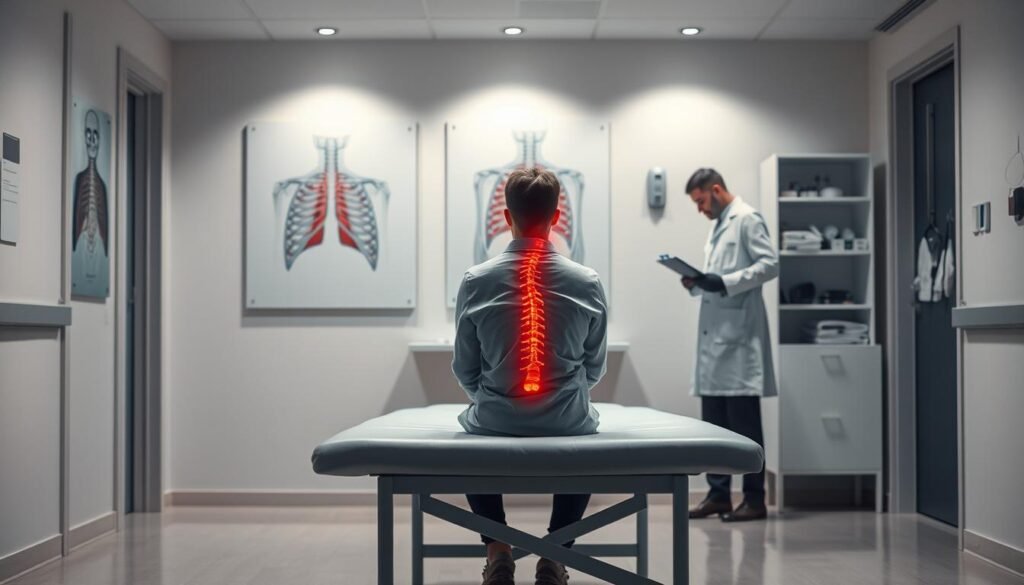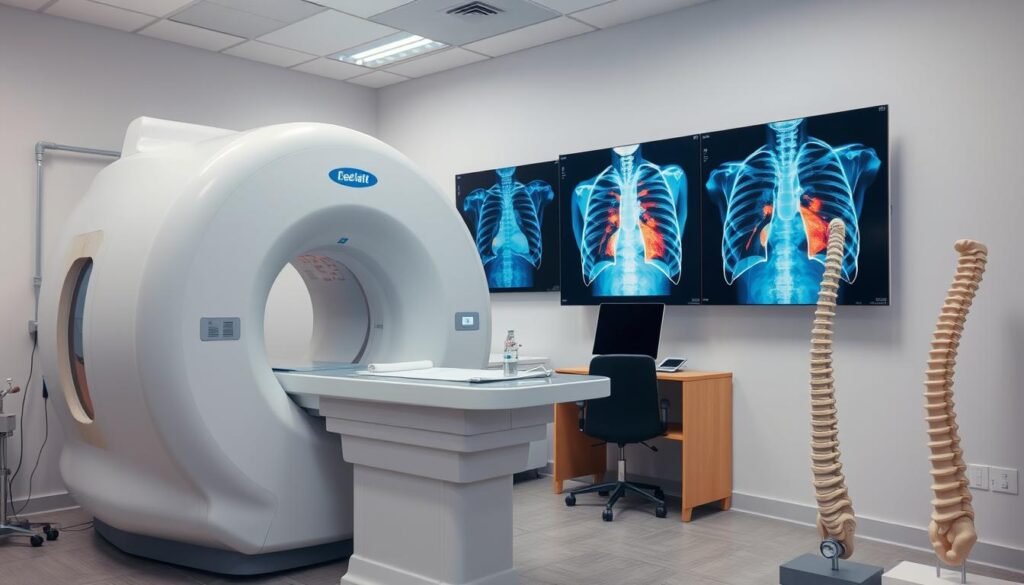About 1 in every 4 people with lung cancer experience back pain. This fact shows us how vital it is to recognize early signs of serious health problems. While many people deal with back pain, it can also point to something scarier like lung cancer. Knowing when to see a doctor for back pain linked to lung cancer is key. It helps with catching the disease early and getting the right treatment. People can better look after their health by knowing the link between these two issues.
This article will cover key lung cancer symptoms and how back pain relates to it. It will also give crucial advice on when to seek medical help. Catching and reporting symptoms early can improve treatment success and boost recovery chances. Understanding early signs, like shoulder pain, can help people manage their health better. For info on early lung cancer signs, click here.
Key Takeaways
- Recognizing back pain as a potential symptom of lung cancer is essential for early detection.
- About 25% of lung cancer patients experience back pain, highlighting the connection between the two.
- Certain types of tumors can put pressure on the spine, leading to back pain.
- It’s vital to differentiate between common back pain causes and potential cancer-related issues.
- Early diagnosis of related back pain can significantly improve treatment outcomes and recovery chances.
- Consulting with a healthcare provider about unusual or persistent back pain is crucial.
- Palliative care options can effectively manage cancer-related back pain, improving quality of life.
Understanding Back Pain
Back pain can be caused by many things, and finding the exact cause is key to solving it. It’s something many will feel at some point in their lives. It often comes from things like small injuries, muscle strains, diseases that get worse over time, or even how we live, like bad posture or being overweight. Problems like arthritis, disc issues, and spinal injuries can make back pain more complicated. Knowing these things can help people understand their own back pain better.
Common Causes of Back Pain
Many factors can lead to ongoing back pain. The most common reasons are:
- Muscle strains from lifting heavy things or sudden moves
- Disc problems, like herniated or bulging discs
- Arthritis, causing swelling and pain
- Bad posture over a lot of time
- Being overweight, which puts more pressure on the spine and muscles
It’s crucial to recognize these causes to handle back pain well. While many back pain cases get better on their own, some need a doctor’s care. Knowing when to see a doctor for back pain is important. Don’t ignore the warning signs.
When Back Pain Becomes Concerning
It’s important to watch out for serious signs of back pain. If back pain doesn’t go away after a few days, it could be something more severe. Other red flags include:
- Weight loss that can’t be explained
- Pain at night or when you lie down
- Back pain with a cough or hard time breathing
If these symptoms show up with back pain, seeing a doctor is a smart move. Some severe conditions, like lung cancer, can show up as back pain, especially with other worrying signs. Getting help early can really make a difference in dealing with back pain and its causes.
Recognizing Lung Cancer Symptoms
Knowing the signs of lung cancer is key to early treatment and better survival rates. Often, symptoms go unnoticed until the disease is far along. Look out for a cough that won’t quit, losing weight without trying, and feeling short of breath. Catching the disease early can greatly help in beating it.
Primary Lung Cancer Signs
Some common signs of lung cancer are:
- Persistent cough that stays.
- Coughing up blood, which occurs in about 20% of cases.
- Chest pain that gets worse when you breathe deeply.
- Unexplained weight loss, sometimes more than 5% of body weight.
- Shortness of breath and getting sick often with lung infections.
Spotting these signs early can mean a quicker diagnosis and a better shot at successful treatment.
How Lung Cancer Can Affect the Back
Lung cancer can cause back pain when tumors press on nearby areas, including nerves. About 25% of people with lung cancer feel back pain. It might feel like a dull or sharp ache. This problem often shows up with other lung cancer signs, like constant coughing and unexpected weight loss.
Knowing how lung cancer triggers back pain helps manage the pain. More importantly, it can highlight the need to take the disease seriously.
The Connection Between Back Pain and Lung Cancer
It’s crucial to understand how tumors can lead to back pain. Tumors in the lungs may press on nearby nerves and tissues. This can cause different types of back pain, from dull aches to sharp pains. The pain varies based on the tumor’s location. Tumors and back pain are closely linked. Spinal metastasis, for instance, can cause serious issues like spinal cord compression. This leads to increasing pain or discomfort.
How Tumors Lead to Back Pain
The process of how tumors cause pain involves several factors. A growing tumor can press on surrounding areas, causing inflammation and discomfort. People with lung cancer might feel back pain from a tumor on the spine or nearby nerves. Pain can get worse with certain movements, indicating a serious issue. Keeping an eye on these symptoms can help tell lung cancer apart from other pain causes.
Distinguishing Lung Cancer Pain from Other Causes
Figuring out the cause of back pain can be hard. If the pain doesn’t go away with rest or usual treatments, see a doctor. Pain that gets worse at night or happens without injury is worrying. Other signs, like unexpected weight loss or a cough lasting more than eight weeks, are red flags. Early lung cancer diagnosis can make a big difference in treatment success. Pay attention to these symptoms if you have lung cancer-related back pain.
When to See a Doctor for Back Pain and Lung Cancer
Knowing when to seek medical help for back pain is important. It’s even more critical when worried about lung cancer. Many people face back pain, with 80% of Americans having it sometime. It’s essential to know when to visit a doctor for back pain and lung cancer for quick help.
Signs That Require Medical Attention
If your back pain lasts more than a few days or gets worse, see a doctor. Look out for:
- Severe or ongoing back pain not eased by home care
- Coughing, unexpected weight loss, or breathing problems
- Chest pain along with back pain, especially if it’s acute
These signs might point to something urgent, like lung cancer. This cancer often reaches the spine. Fast doctor visits can lead to better health results.
Reporting Symptoms to Your Doctor
Talking clearly to your doctor is key. Telling them your symptoms well helps them see the full picture and check for lung cancer. Things to share include:
- How long the back pain has lasted and any symptom changes
- If you have a cough, are tired, or losing weight without reason
- Your cancer history or any risk factors
Providing all these details helps your doctor possibly diagnose you correctly. For more on back pain and cancer, click here.

Examining Specific Symptoms
Knowing the specific symptoms of lung cancer is key to making wise health choices. A persistent cough and other signs may point to lung issues. It’s vital to recognize these early for timely help.
Persistent Cough and Breathing Difficulties
A constant cough and trouble breathing could mean serious lung problems like cancer. These symptoms usually come together, hinting at a major health issue. If you’re coughing a lot and can’t breathe well, see a doctor to check if it’s something serious.
Unexplained Weight Loss
Suddenly losing weight without trying can be a red flag for many diseases, like lung cancer. If you’re also having back pain or breath troubles, it might be linked to lung cancer. It’s wise to get a doctor’s opinion quickly in such cases.
Chest Discomfort Associated with Back Pain
Chest pain paired with back pain could be a sign of something serious, like lung cancer. Especially if you also have a cough or breathing issues, you should get checked by a doctor right away. Early action can lead to better treatment results.
Testing and Diagnosis
It’s crucial to understand how doctors diagnose back pain and lung cancer. These two conditions can feel similar at times. Knowing the testing methods helps spot problems early, which aids in finding the right treatments quickly.
Diagnostic Procedures for Back Pain
To start diagnosing back pain, doctors do a full exam and listen to the patient’s history. They often suggest imaging tests for more clues. These tests help see what’s happening inside.
- X-rays – to look for broken bones or how bones line up
- MRI – provides in-depth pictures of soft tissues like muscles and spinal discs
- CT scans – show detailed views of the spine and other areas
These tests are key in finding out the exact problem behind back pain. It could be an injury or something more complex.
Evaluation for Lung Cancer
Doctors use several tools to check for lung cancer. They usually start with a chest X-ray. If needed, they move on to CT scans, which are better at finding tumors in the lungs. More tests can include:
- Biopsies – getting tissue samples, often through bronchoscopy or a needle
- Sputum cytology – examining lung mucus for cancer cells
- PET scans – used to see the cancer’s stage and if it’s spread
Getting a correct diagnosis for lung cancer means using these tools and paying attention to symptoms. It’s especially important to notice if back pain might be linked to lung issues. This helps doctors make the right diagnosis.

Treatment Options for Back Pain
There are many ways to help those suffering from back pain due to lung cancer. The focus is often on treating the cancer and managing the pain. This approach aims to improve comfort and life quality.
Management of Pain Related to Lung Cancer
The pain lung cancer patients feel can differ a lot. It depends on how much the cancer has grown or spread. If cancer reaches the bones or spine, managing pain gets harder. Patients usually try different lung cancer treatment options. These might include drugs, physical therapy, and palliative care for pain relief.
Palliative treatments focus on easing pain, not curing the illness. They are crucial for the patient’s comfort and well-being.
Over-the-Counter vs. Prescription Medications
Sometimes, over-the-counter medications like NSAIDs or acetaminophen can lessen mild to moderate pain. Yet, if the pain gets worse or is very bad, doctors may prescribe stronger painkillers. These can be opioids, which are more effective against severe pain.
Additionally, treatments like acupuncture and physical therapy can help. Also, self-care acts, such as exercising regularly, are key in managing pain.
Living with Lung Cancer
Lung cancer patients often deal with pain and emotional stress. Supportive care is key to improving their quality of life. It focuses on easing symptoms and addressing emotional needs through palliative care.
Supportive Care and Palliative Options
Supportive care uses a whole-person approach. It includes physical therapy, medicine, and changes in lifestyle to manage pain. Palliative care teams offer custom help for specific symptoms and better daily living. This is key for those with advanced lung cancer and spine issues. The emotional support these teams provide is vital. It helps with anxiety, depression, and feeling alone.
The Importance of Communication with Healthcare Providers
Good communication with doctors is crucial for lung cancer patients. A strong patient-doctor bond leads to open talks about symptoms, treatments, and worries. Being involved in care discussions lets patients have their choices heard. This leads to better care adjustments and emotional health. Working together with doctors leads to better health results.

| Aspect | Benefits |
|---|---|
| Supportive Care | Enhances quality of life, manages symptoms effectively |
| Palliative Care | Provides relief from pain and assists in emotional support |
| Communication | Fosters a collaborative patient-doctor relationship, allows for personalized care |
Lung cancer brings many challenges, but supportive care and good communication with doctors can make the treatment journey more manageable. This helps patients feel more comfortable and confident.
Preventive Measures and Lifestyle Changes
Leading a healthy life is key in fighting diseases like lung cancer. Taking steps to prevent disease lowers your cancer risk. Making small changes every day can improve your health greatly.
Maintaining a Healthy Lifestyle
Living healthily involves making good choices. Important factors are:
- Nutrition: Eating lots of fruits, veggies, whole grains, and using healthy fats like olive oil cuts breast cancer risk and boosts health.
- Weight Management: Staying at a healthy weight lowers the chance of getting several cancers, like those of the breast, pancreas, and liver.
- Avoiding Tobacco: Smoking is linked to many cancers. Stopping smoking can greatly better your health over time.
- Regular Screenings: Self checks and getting screenings as recommended help find cancers early when they are easier to treat.
Exercise and Physical Therapy Options
Adding exercise to your life enhances health and fights disease. Doing moderate exercise for 150 minutes a week or vigorous exercise for 75 minutes cuts cancer risk, especially for breast and colon cancer. Back pain? Physical therapy strengthens muscles and makes you more flexible, for a healthier you.
Let’s compare some exercise choices and their perks:
| Type of Exercise | Benefits |
|---|---|
| Walking | Boosts heart health, helps with weight control. |
| Strength Training | Makes muscles stronger, boosts metabolism. |
| Yoga | Makes you more flexible, decreases stress and back pain. |
| Swimming | A gentle way to build endurance and strength. |
Exercise and eating well help manage weight and strengthen you during cancer treatment. Choosing a healthy lifestyle lets you take control to live better.
Conclusion
Learning how back pain and lung cancer are connected is key to better health. The importance of early detection is very high. It can make a big difference in survival and treatment success. About 25% of people with lung cancer feel back pain, which might be ignored as something less serious. So, it’s important to pay attention to ongoing back pain. It could be a sign of a bigger health issue. Check out this detailed guide for more information.
It’s also crucial to notice other signs like losing weight, feeling tired, and coughing without a reason. Lung cancer is the top cause of death from cancer around the world. Being proactive about your health is very important. Finding out what’s wrong early can help manage health problems better and avoid serious issues.
In summary, if you have symptoms like back pain, don’t wait to get help. Knowing about the link between back pain and lung cancer can lead to better health care sooner. Early action and working with doctors are key to improving chances for a good outcome.